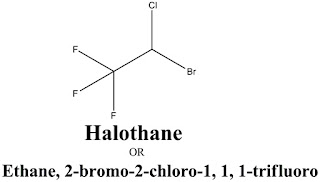Introduction : Halothane belongs to the group of Anesthetics particularly General Anesthetics. Description It is a relatively safe poten...
Introduction:
Halothane belongs to the group of Anesthetics particularly General Anesthetics.
Description
It is a relatively safe potent volatile anaesthetic administered by inhalation. It is twice as potent as chloroform and 4 times that of ether. It may produce any depth of anaesthesia without causing hypoxia. Being a non-irritant, its inherent hypotensive effect retards capillary bleeding and renders a comparatively bloodless field.
Analysis
Physical Properties of Halothane
Structure and Synthesis of Halothane
Halothane belongs to the group of Anesthetics particularly General Anesthetics.
Description
It is a relatively safe potent volatile anaesthetic administered by inhalation. It is twice as potent as chloroform and 4 times that of ether. It may produce any depth of anaesthesia without causing hypoxia. Being a non-irritant, its inherent hypotensive effect retards capillary bleeding and renders a comparatively bloodless field.
Analysis
| Indication | For the induction and maintenance of general anesthesia |
| Pharmacodynamics | Halothane is a general inhalation anesthetic used for induction and maintenance of general anesthesia. It reduces the blood pressure and frequently decreases the pulse rate and depresses respiration. It induces muscle relaxation and reduces pains sensitivity by altering tissue excitability. It does so by decreasing the extent of gap junction mediated cell-cell coupling and altering the activity of the channels that underlie the action potential. |
| Mechanism of action | Halothane causes general anaethesia due to its actions on multiple ion channels, which ultimately depresses nerve conduction, breathing, cardiac contractility. Its immobilizing effects have been attributed to its binding to potassium channels in cholinergic neurons. Halothane's effect are also likely due to binding to NMDA and calcium channels, causing hyperpolarization. |
Physical Properties of Halothane
2-bromo-2-chloro-1,1,1-trifluoroethane
Chemical Formula: C2HBrClF3
Exact Mass: 195.89
Molecular Weight: 197.38
m/z: 197.89 (100.0%), 195.89 (77.4%), 199.89 (24.1%), 198.89 (2.2%), 196.89 (1.7%)
Elemental Analysis: C, 12.17; H, 0.51; Br, 40.48; Cl, 17.96; F, 28.88
Chemical Formula: C2HBrClF3
Exact Mass: 195.89
Molecular Weight: 197.38
m/z: 197.89 (100.0%), 195.89 (77.4%), 199.89 (24.1%), 198.89 (2.2%), 196.89 (1.7%)
Elemental Analysis: C, 12.17; H, 0.51; Br, 40.48; Cl, 17.96; F, 28.88
Structure and Synthesis of Halothane


No comments